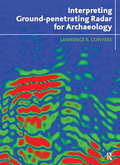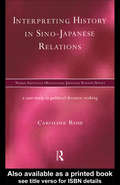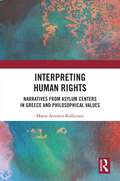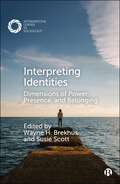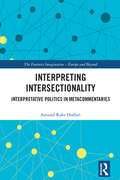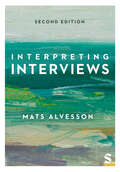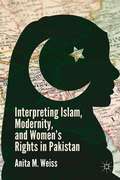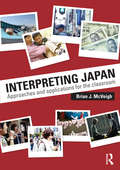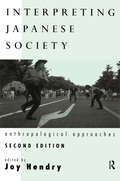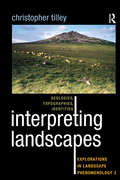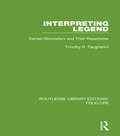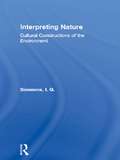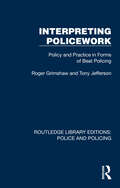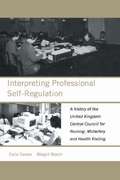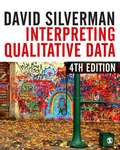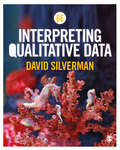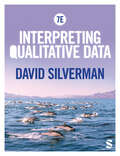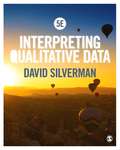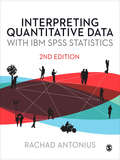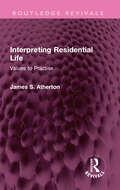- Table View
- List View
Interpreting Disability: A Qualitative Reader
by Philip M. Ferguson Dianne M. Ferguson Steven J. TaylorThis text provides stories that illustrate interpretivistic research related to disability.
Interpreting Diversity: Europe and the Malay World
by Christina SkottThis volume departs from conventional historiography concerned with colonialism in the Malay world, by turning to the use of knowledge generated by European presence in the region. The aim here is to map the ways in which European observers and scholars interpreted the ethnic, linguistic and cultural diversity which has been seen as a hallmark of Southeast Asia. With a chronological scope of the eighteenth to the early twentieth century, contributors examine not only European writing on the Malay world, but the complex origins of various forms of knowledge, dependent on local agency but always closely intertwined with contemporary metropolitan scientific and scholarly ideas. Knowledge of the peoples, languages and music of the Malay world, it is argued, came to inform and shape European scholarship within a variety of areas, such as Enlightenment science and anthropology, ideas of human progress, philological theory, ethnomusicology and emerging theories of race. But this volume also contributes to ongoing debates within the region, by discussing ideas about the Malay language and definitions of ‘Malayness’. The last chapters of the book present a reversed viewpoint, in examinations of how local cultural forms, theatrical traditions and literature were reshaped and given new meaning through encounters with cosmopolitanism and perceived modernity. This book was previously published as a special issue of Indonesia and the Malay World.
Interpreting Ground-penetrating Radar for Archaeology
by Lawrence B ConyersGround-penetrating radar (GPR) has become one of the standard tools in the archaeologist's array of methods, but users still struggle to understand what the images tell us. In this book—illustrated with over 200 full-color photographs—Lawrence Conyers shows how results of geophysical surveys can test ideas regarding people, history, and cultures, as well as be used to prospect for buried remains. Using 20 years of data from more than 600 GPR surveys in a wide array of settings, Conyers, one of the first archaeological specialists in GPR, provides the consumer of GPR studies with basic information on how the process works. He show how the plots are generated, what subsurface factors influence specific profiles, how the archaeologist can help the surveyor collect optimal data, and how to translate the results into useable archaeological information.
Interpreting History in Sino-Japanese Relations: A Case-Study in Political Decision Making (Nissan Institute/Routledge Japanese Studies #10)
by Caroline RoseThe first book-length study to examine the re-writing of school textbooks by the Japanese Education Ministry in an attempt to play down atrocities in China during World War II. The famous textbook crisis in 1982 was at the centre of a diplomatic storm extending through the 1980s as Sino-Japanese relations were beset by a series of political controversies. This fascinating account of the period reveals that Chinese and Japanese policy-makers were more concerned with changes taking place in international and domestic politics than with adopting a correct view of history.
Interpreting Human Rights: Narratives from Asylum Centers in Greece and Philosophical Values
by Maria-Artemis KolliniatiKolliniati’s groundbreaking book, Interpreting Human Rights: Narratives from Asylum Centers in Greece and Philosophical Values, challenges the notion that the interpretation and application of human rights primarily occur within the corridors of power in Strasbourg or official European institutions. It argues that such interpretation takes place in the grassroots settings of rural areas and neighborhoods, by actors who do not belong to the class of decision‑making elites.Focusing on the Aegean islands as exemplary sites of the European refugee crisis, this book draws on research conducted among local actors, including mayors, municipal councilors, representatives of NGOs and staff at refugee reception and identification centers. This book is divided into five distinctive sections: Methodology; Legal Framework and the Emergence of Hotspots; Empirical Research: Narratives of Local Actors; Local Narratives and Political Attitudes; and Glocalization of Human Rights. The study explores the role of human rights in narratives surrounding refugee flows, categorizing responses according to various political theory approaches such as global liberalism, egalitarianism, communitarianism and conservatism. By integrating applied political theory with localized human rights interpretations, this book offers actionable steps for addressing the challenges of migration in today’s interconnected world.By amplifying the voices of those directly engaged with one of contemporary Europe’s most significant challenges, Interpreting Human Rights will appeal to scholars of sociology, political theory, politics and international law, particularly those interested in migration, human rights and refugee studies.
Interpreting Identities: Dimensions of Power, Presence, and Belonging (Interpretive Lenses in Sociology)
by Wayne H. Brekhus and Susie ScottThis edited collection brings together social scientists to interpret identity from a wide range of analytical perspectives. Drawing on multiple interpretive traditions from the last 100 years, the book explores how underlying social, cultural and psychological forces shape the dimensions of identity. Chapters emphasize how identity forms and functions in relation to key sociological issues such as social power, social control and the production and reproduction of social inequalities. Contributors also explore the flexibility of identities, showcasing how different perspectives and analytical tools reveal the nuances of rejected, unrealized and aspirational identities. By navigating these dimensions, the book reveals the interplay between personal biography and broader social life.
Interpreting Intersectionality: Interpretative Politics in Metacommentaries (The Feminist Imagination - Europe and Beyond)
by Amund Rake HoffartAgainst the backdrop of the emergence of intersectionality as a dominant paradigm in feminist scholarship and activism, this book explores the genre of metacommentaries as critical responses to the development of intersectionality as a paradigm. With attention to the dispersal of intersectionality into ever-newer contexts – and the missteps and breakdowns that occur during this process – it addresses the concern that intersectionality is transforming into something unrecognisable, drifting too far away from its foundational sources and visions and becoming diluted by its expansion. Examining the process by which metacommentaries engage in a form of corrective storytelling – seeking to rescue intersectionality from misuse by pinning it down and returning it to where it belongs – Interpreting Intersectionality presents a critique of these gestures of correction, arguing that, far from reconnecting intersectionality with its roots and enabling it to realise its potential, such metacommentaries actually bind the scholarly discourse on intersectionality to an either/or argumentative dynamic. It will therefore appeal to scholars and students with an interest in feminist theory, gender studies and/or intersectional analysis.
Interpreting Interviews
by Mats AlvessonThrough the use of eight original metaphors for understanding what may happen in interviews and what may guide the interviewee (more than telling the truth or revealing experiences), the reader is encouraged to do interviews in clever ways. This text enables you to question the interpretive nature and theoretical underpinnings of the interview method, and of the knowledge which is conveyed through it. The updated second edition includes new content on: • How to avoid traps in interviews • How to use interviewees with experience and insight • How to work creatively with generative material • The value of repeat interviewing over time • The importance of supplementing interviews with other methods • Possibilities of interview-based research accompanied by examples This text is essential reading for upper undergraduate and postgraduate students of qualitative methods, and researchers looking to more clearly conceptualize their interviewing practice and explore its theoretical basis. Mats Alvesson is professor at University of Bath and is also affiliated with Lund University, Stockholm School of Economics and Bayes Business School.
Interpreting Interviews
by Mats AlvessonThrough the use of eight original metaphors for understanding what may happen in interviews and what may guide the interviewee (more than telling the truth or revealing experiences), the reader is encouraged to do interviews in clever ways. This text enables you to question the interpretive nature and theoretical underpinnings of the interview method, and of the knowledge which is conveyed through it. The updated second edition includes new content on: • How to avoid traps in interviews • How to use interviewees with experience and insight • How to work creatively with generative material • The value of repeat interviewing over time • The importance of supplementing interviews with other methods • Possibilities of interview-based research accompanied by examples This text is essential reading for upper undergraduate and postgraduate students of qualitative methods, and researchers looking to more clearly conceptualize their interviewing practice and explore its theoretical basis. Mats Alvesson is professor at University of Bath and is also affiliated with Lund University, Stockholm School of Economics and Bayes Business School.
Interpreting Islam, Modernity, And Women’s Rights In Pakistan
by Anita M. WeissIn Pakistan, myriad constituencies are grappling with reinterpreting women's rights. This book analyzes the Government of Pakistan's construction of an understanding of what constitutes women's rights, moves on to address traditional views and contemporary popular opinion on women's rights, and then focuses on three very different groups' perceptions of women's rights: progressive women's organizations as represented by the Aurat Foundation and Shirkat Gah; orthodox Islamist views as represented by the Jama'at-i-Islami, the MMA government in Khyber Pakhtunkhwa (2002-08) and al-Huda; and the Swat Taliban. Author Anita M. Weiss analyzes the resultant "culture wars" that are visibly ripping the country apart, as groups talk past one another - each confidant that they are the proprietors of culture and interpreters of religion while others are misrepresenting it.
Interpreting Japan: Approaches and Applications for the Classroom
by Brian J. McVeighWritten by an experienced teacher and scholar, this book offers university students a handy "how to" guide for interpreting Japanese society and conducting their own research. Stressing the importance of an interdisciplinary approach, Brian McVeigh lays out practical and understandable research approaches in a systematic fashion to demonstrate how, with the right conceptual tools and enough bibliographical sources, Japanese society can be productively analyzed from a distance. In concise chapters, these approaches are applied to a whole range of topics: from the aesthetics of street culture; the philosophical import of sci-fi anime; how the state distributes wealth; welfare policies; the impact of official policies on gender relations; updated spiritual traditions; why manners are so important; kinship structures; corporate culture; class; schooling; self-presentation; visual culture; to the subtleties of Japanese grammar. Examples from popular culture, daily life, and historical events are used to illustrate and highlight the color, dynamism, and diversity of Japanese society. Designed for both beginning and more advanced students, this book is intended not just for Japanese studies but for cross-cultural comparison and to demonstrate how social scientists craft their scholarship.
Interpreting Japanese Society: Anthropological Approaches
by Joy HendryFirst published in 1986, Interpreting Japanese Society became something of a classic in the field. In this newly revised and updated edition, the value of anthropological approaches to help understand an ancient and complex nation is clearly demonstrated.While living and working in Japan the contributors have studied important areas of society. Religion, ritual, leisure, family and social relations are covered as are Japanese preconceptions of time and space - often so different from Western concepts.This new edition of Interpreting Japanese Society shows what an important contribution research in such a rapidly changing industralised nation can make to the subject of anthropology. It will be welcomed by students and scholars alike who wish to find refreshing new insights on one of the world's most fascinating societies.
Interpreting Landscapes: Geologies, Topographies, Identities; Explorations in Landscape Phenomenology 3 (Explorations In Landscape Phenomenology; Ser.)
by Christopher TilleyThis book takes a new approach to writing about the past. Instead of studying the prehistory of Britain from Mesolithic to Iron Age times in terms of periods or artifact classifications, Tilley examines it through the lens of their geology and landscapes, asserting the fundamental significance of the bones of the land in the process of human occupation over the long durée. Granite uplands, rolling chalk downlands, sandstone moorlands, and pebbled hilltops each create their own potentialities and symbolic resources for human settlement and require forms of social engagement. Taking his findings from years of phenomenological fieldwork experiencing different landscapes with all senses and from many angles, Tilley creates a saturated and historically imaginative account of the landscapes of southern England and the people who inhabited them. This work is also a key theoretical statement about the importance of landscapes for human settlement.
Interpreting Legend: Danish Storytellers and their Repertoires (Routledge Library Editions: Folklore)
by Timothy R. TangherliniThis book, first published in 1994, sets ‘repertoire against raconteur’ in order to explore one of the world’s largest collections of folk literature. The author’s findings, and his creative and synthetic methodologies, enhance greatly our understanding of the world of the legend, and especially the basic question of ‘Who tells what to whom in the form of a legend and why?’ This work is an in-depth exploration of rural Denmark, and provides us with an excellent vantage point from which to understand legends in their cultural contexts and within the lives of their tellers.
Interpreting Nature: Cultural Constructions of the Environment
by I. G. SimmonsHuman society has constructed many varied notions of the environment. Scientific information about the environment is often seen as the only worthwhile knowledge. This ignores the complexities created by interaction between people and the environment. Idealist thinking argues that everything we know is based on a construct of our minds and that all is possible. Can both be correct and true? Interpreting Nature explores the position of humanity in the environment from the principle that the models we construct are imperfect and can only be provisional. Having examined the way in which the natural sciences have interrogated nature, the types of data produced and what they mean to us, this looks at the environment within philosophy and ethics, the social sciences and the arts, and analyses their role in the formation of environmental cognition.
Interpreting Policework: Policy and Practice in Forms of Beat Policing (Routledge Library Editions: Police and Policing)
by Tony Jefferson Roger GrimshawIn the 1980s there existed wide and often acrimonious disagreement over the purposes and objectives of police organizations, the ways in which their activities were structured, and their relations with the wider society. Interpreting policework requires a rounded conception of policing, based on both a thorough critique of the main theoretical trends in police sociology, and close familiarity with actual patterns of policing, on the streets, in the stations, and inside the police headquarters where key policies are formulated. Originally published in 1987, the achievement of this book is that it combines rigorous theoretical analysis with a wealth of descriptive material drawn from first-hand observation of policing and decision making at all levels, and thus relates sociological theory to practice and political debate at the time. The introduction provides a careful analysis of central theoretical and political strands in police sociology, and proposes a new general conception of policework. The authors go on to provide vivid illustrations of this conception from the worlds of uniformed unit beat patrols and resident beat officers, and from the fora in which policy for operational practice is considered. A final section draws the wider lessons of these concrete analyses for sociological theory and for our understanding of past policy shifts from one form of beatwork to another, and spells out the radical implications of the study for the political debate on the future of policing. Interpreting Policework thus had relevance to students and researchers in police studies, sociology, public policy and the law at the time and will still be of historical interest today. The authors are experienced researchers, practised in investigating a wide range of criminological and social control issues.
Interpreting Professional Self-Regulation: A History of the United Kingdom Central Council for Nursing, Midwifery and Health Visiting
by Celia Davies Abigail BeachInterpreting Professional Self-Regulation analyses the contribution made by the UKCC to the development of the nursing profession in this country over the last 30 years.It details the key issues the council grappled with during this time and provides in-depth analyses of the complexity of these issues.There is a general consensus that the current view of nursing's regulatory body will culminate in a major shake up of the way the nursing profession is governed and in which the UKCC will be radically transformed. This publication of the history of the UKCC will mark the close of a very significant period in nursing's history and the opening of wider debates about ensuring the safety of the public through regulation of health professionals.This is an important text for all those who teach on professional and policy issues in nursing, giving them a factual background that has never been brought together before, enabling them to bring discussion of post-registration education, discipline and other professional matters more firmly into the curriculum.
Interpreting Qualitative Data
by David SilvermanThis is the perfect book for any student new to qualitative research. In this exciting and major updating of his bestselling, benchmark text, David Silverman walks the reader through the basics of gathering and analysing qualitative data. David Silverman offers beginners unrivalled hands-on guidance necessary to get the best out of a research methods course or an undergraduate research project. New to the fourth edition: - A new chapter on data analysis dealing with grounded theory, discourse analysis and narrative analysis - Further worked-through examples of different kinds of data and how to interpret them - A separate section on focus groups and interpreting focus group data - An expanded ethics chapter - More coverage of digital media and photographs as data - A companion website with additional case studies and examples, links to SAGE journals online, and links to useful websites, podcasts and Youtube videos. This fourth edition is also accompanied with its own group page on www. methodspace. com where users can give feedback and discuss research issues. Visit www. methodspace. com/group/silverman
Interpreting Qualitative Data
by David Silverman"Cutting-edge and friendly. Offers even more of what we've come to expect. Practical, yet conceptually astute. Critically attuned to new developments, such as the uses and misuses of mixed methods designs and the convenience of smart phone technology. Packaged in an approachable format that virtually welcomes the reader aboard" - Jaber F. Gubrium, University of Missouri With a wealth of examples and learning features, the book takes a practical approach to methods training and provides a strong foundation in research design for social science students. In his characteristic positive writing style, author David Silverman offers useful advice on sticking points faced by beginner researchers and helps you build your confidence. Central to this sixth edition are its online resources, including: Entertaining and inspiring videos from the author that help you unpack concepts, boost your understanding and think critically An &‘assessment corner&’, offering practical help and tailored support for typical assignments e.g. group reports and literature reviews A downloadable workbook providing a hands on way to get to grips with the necessary skills for gathering, analysing and interpreting qualitative data Approachable, clear and friendly, this book equips you with the tools to tackle key issues faced by qualitative researchers and establish good practice in your own research.
Interpreting Qualitative Data
by David SilvermanIn his signature pragmatic and friendly style, David Silverman acts as your stand-in supervisor in the seventh edition of this book, taking you step-by-step through different methods for making sense of qualitative data. Whether you are interested in analysing visual images, interviews, focus groups or online data, this book provides a clear framework for using qualitative data to answer your research questions. The book provides: • A strong grounding in research design principles so you can embed best practice into your research project. • Diverse real-world examples so you can see how principles are applied in practice. • Coverage of new developments in qualitative research including working with online data. If you are new to qualitative research or conducting your first research project in the social sciences, this book gives you the practical grounding in qualitative methods you need to get started.
Interpreting Qualitative Data
by David SilvermanIn his signature pragmatic and friendly style, David Silverman acts as your stand-in supervisor in the seventh edition of this book, taking you step-by-step through different methods for making sense of qualitative data. Whether you are interested in analysing visual images, interviews, focus groups or online data, this book provides a clear framework for using qualitative data to answer your research questions. The book provides: • A strong grounding in research design principles so you can embed best practice into your research project. • Diverse real-world examples so you can see how principles are applied in practice. • Coverage of new developments in qualitative research including working with online data. If you are new to qualitative research or conducting your first research project in the social sciences, this book gives you the practical grounding in qualitative methods you need to get started.
Interpreting Qualitative Data: Methods For Analysing Talk, Text And Interaction
by David SilvermanIn this exciting and major updating of one the most important textbooks for beginning qualitative researchers, David Silverman seeks to match the typical chronology of experience faced by the student-reader. Earlier editions of Interpreting Qualitative Data largely sought to provide material for students to answer exam questions, yet the undergraduate encounter with methods training is increasingly assessed by students doing their own research project. In this context, the objective of the Third Edition is to offer undergraduates the kind of hands-on training in qualitative research required to guide them through the process.
Interpreting Qualitative Data: Methods For Analysing Talk, Text And Interaction
by David SilvermanIn this fifth edition of his field-defining text, David Silverman, a true guru of qualitative research, walks the reader through the basics of gathering and analyzing qualitative data. The book offers beginners unrivalled hands-on guidance to help them get the best out of a research methods course or research project. New to the fifth edition: A streamlined structure to aid navigation and guide readers smoothly through the research process. A new chapter on generalizing from case-study research which addresses the perennial issue of ‘how many cases do you need?’ New material on doing qualitative research online and the ethics of internet research. Additional sections covering organizational documents and documents of everyday life, including blogs and diaries. Many more recent case study examples drawn from a broad range of disciplines including business, education, social work and geography as well as health studies. A new and improved companion website, full of additional resources for students and lecturers. This is the perfect companion for all those new to qualitative research. Available with Perusall—an eBook that makes it easier to prepare for class Perusall is an award-winning eBook platform featuring social annotation tools that allow students and instructors to collaboratively mark up and discuss their SAGE textbook. Backed by research and supported by technological innovations developed at Harvard University, this process of learning through collaborative annotation keeps your students engaged and makes teaching easier and more effective. Learn more.
Interpreting Quantitative Data with IBM SPSS Statistics
by Rachad AntoniusThe second edition of Interpreting Quantitative Data with IBM SPSS Statistics is an invaluable resource for students analysing quantitative data for the first time. The book clearly sets out a range of statistical techniques and their common applications, explaining their logic and links to the research process. It also shows how SPSS can be used as a tool to aid analysis. Key features of the second edition include: - new chapters on one-way and two-way ANOVA, the Chi-square test and linear regression. - SPSS lab sessions following each chapter which demonstrate how SPSS can be used in practice - sets of exercises and 'real-life' examples to aid teaching and learning - lists of key terms to aid revision and further reading to enhance students' understanding - an improved text design making the book easier to navigate - a companion website with answers to the labs and exercises, along with additional data sets and powerpoint slides
Interpreting Residential Life: Values to Practise (Routledge Revivals)
by James S. AthertonFirst published in 1989 Interpreting Residential Life raises questions like – a) what makes residential establishments tick, b) what is going on beneath the surface of the daily routine, c) why is change so difficult to create and even more difficult to sustain, and d) how can residential social workers evaluate their work? James Atherton provides a set of tools to enable residential workers to answer these questions in their own establishments. Simply and directly, he provides a framework which shows how policy and practice relate to each other and reinforce or hinder each other, in crises as well as in routines. He examines the whole residential establishment as a social system, concentrating on daily life within it, and demonstrating how values are implicit in all aspects of practice. He draws on the experiences of residential staff at all levels to uncover the working myths and offers ways of understanding how establishments function and indicates the pathways to change. This is an essential read for students of social work and sociology.


